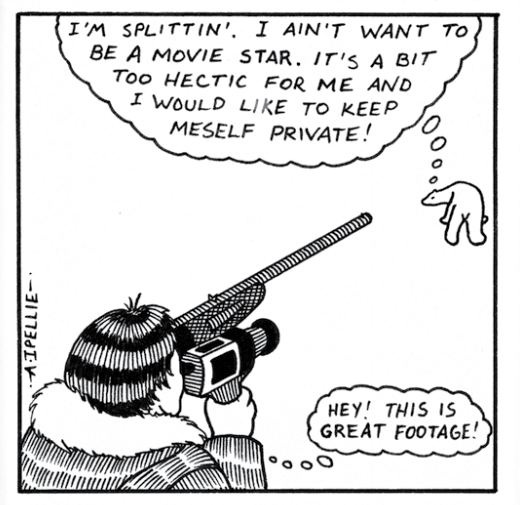One last look at Alootook
Gallery 1C03 is the last venue for the touring exhibit
For its second art exhibit of the year, Gallery 1C03 hosts Carleton University’s (CU) Walking Both Sides of an Invisible Border.
It is an exhibit that examines the artwork of Inuit artist Alootook Ipellie, which is something CU’s art gallery director Sandra Dyck says is long overdue.
“This is the first career retrospective of an extraordinary but under-recognized artist,” she says. “This exhibition brings together, for the first time, the wide-ranging work of drawings, cartoons and comic strips, poetry and essays that Ipellie made over the course of his career, demonstrating the importance, power and impact of his drawings, his words and his vision.”
A comic panel by Alootook Ipellie, the Baffin Island-born artist who lived and worked in Ottawa until his death in 2007. // Photo by Justin Wonnacott, courtesy of Carleton University Art Gallery
Born in Nuvuqquq on Baffin Island in 1951, Ipellie, like many other Inuit at that time in the Canadian Arctic, moved into southern, more urban communities through government sponsorships. Ipellie settled in Ottawa and was known for his work as a translator, illustrator and reporter for Inuit Monthly.
He died in 2007.
Gallery 1C03’s curator Jennifer Gibson echoes Dyck’s assertion, as she feels that Ipellie’s work has been underappreciated in certain artistic circles. “This show is important, as it brings greater recognition to his work, especially amongst younger people,” she says.
“Not long after this exhibit premiered, Ipellie was inducted into the Canadian Cartoonist Hall of Fame.” Both curators highlight the importance of Ipellie’s work and the futuristic applications of his work.
“When you look at his work initially, a common assumption would be that these were created a few years ago, but then you realize that he was creating a work that critiqued the cultural, political and social issues Inuit communities face,” Gibson says.
Dyck agrees and points to Ipellie’s The Colonization of the Arctic, an essay that traces the history and ongoing impacts of colonialism in Inuit Nunangat (the Inuktitut word for the Inuit homeland), as an example of his efforts to discuss sovereignty, politics and climate change.
Ipellie’s work can also be extended to other Indigenous communities. The recent controversial gas pipeline construction on traditional Wet’suwet’en territory in British Columbia, and the Manitoba Hydro dam protest in Winnipeg last November have rekindled discussions surrounding the very themes Ipellie explored.
Both curators agree that art can be a good conduit to get these messages across and deepen these discussions.
“There are numerous contemporary artists, and artists like Ipellie who are no longer with us, who are speaking truth to power,” Gibson says. “Artists have the capacity to reflect on socio-political affairs, and art is an excellent way to draw people into discussion about these events.”
Dyck points out that Ipellie’s body of work is defined, at its heart, by his lifelong struggle to reconcile the two worlds in which he lived, Inuit Nunangat and southern Canada.
She says that his work presents a unique opportunity for non-Inuit, and by extension, non-Indigenous people, to learn of the cultural and social issues Indigenous people continue to face.
“As he wrote in the remarkable poem for which the exhibition is named, Walking Both Sides of an Invisible Border, he did not ‘ask to be forced to learn an alien culture with an alien language,’” Dyck says.
“Qallunaat (non-Inuit) have so much to learn from Ipellie and his extraordinary work."
Published in Volume 74, Number 20 of The Uniter (March 5, 2020)







